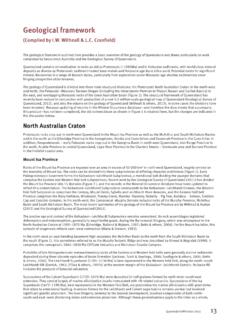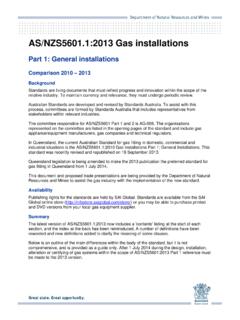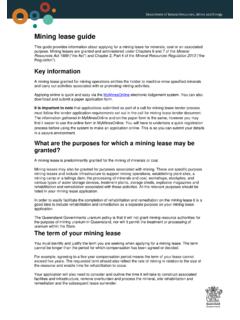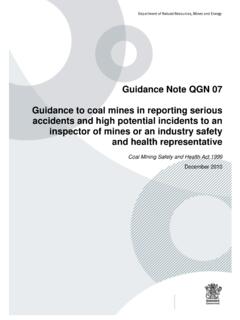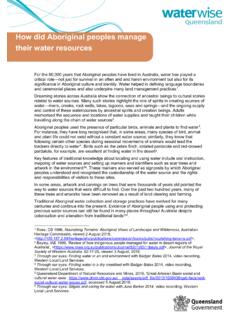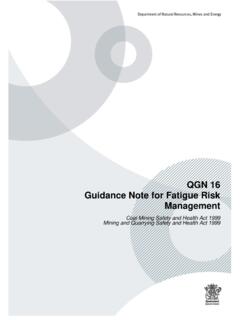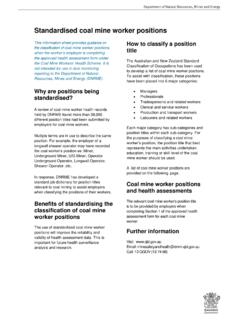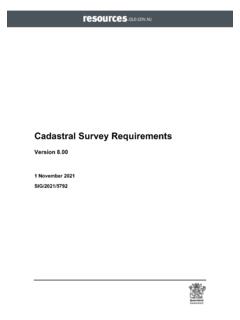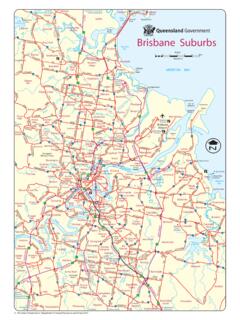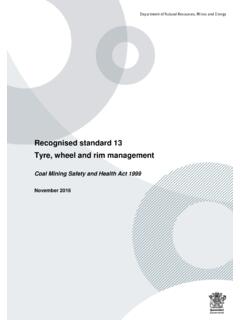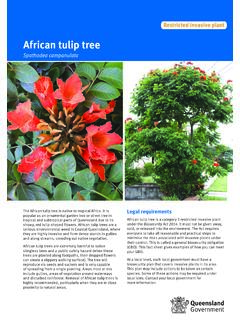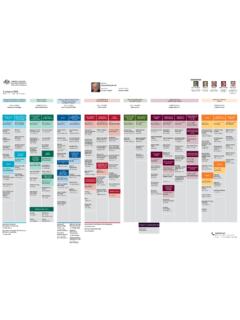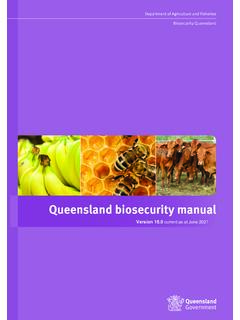Transcription of Land Access Code 2016 - resources.qld.gov.au
1 land Access code Department of Natural Resources and Mines September 2016 Version 2 This publication has been compiled by land and Mines Policy, Department of Natural Resources and Mines State of queensland , 2016 The queensland Government supports and encourages the dissemination and exchange of its information. The copyright in this publication is licensed under a Creative Commons Attribution Australia (CC BY) licence. Under this licence you are free, without having to seek our permission, to use this publication in accordance with the licence terms. You must keep intact the copyright notice and attribute the State of queensland as the source of the publication. Note: Some content in this publication may have different licence terms as indicated.
2 For more information on this licence, visit The information contained herein is subject to change without notice. The queensland Government shall not be liable for technical or other errors or omissions contained herein. The reader/user accepts all risks and responsibility for losses, damages, costs and other consequences resulting directly or indirectly from using this information. Table of contents PART 1 INTRODUCTION .. 1 1 Background .. 1 2 Purpose and application .. 1 PART 2 GOOD RELATIONS .. 2 3 Introduction .. 2 4 General principles .. 3 5 Communication .. 3 6 Negotiating agreements .. 5 7 Communication before and during the carrying out of activities .. 5 8 After completion of 5 PART 3 MANDATORY CONDITIONS FOR RESOURCE AUTHORITIES.
3 6 9 What this part is about .. 6 10 Giving notice .. 6 11 Definitions .. 6 12 Induction training .. 7 13 Access points, roads and 7 14 Livestock and property .. 7 15 Obligations to prevent spread of declared pests .. 8 16 Camps .. 9 17 Items brought onto land .. 9 18 Gates, grids and fences .. 9 PART 4 USEFUL CONTACTS AND FURTHER INFORMATION .. 10 land Access code , Department of Natural Resources and Mines, 2016 1 PART 1 INTRODUCTION 1 Background The queensland Government is committed to balancing the interests of the agricultural and resource sectors to address issues related to land Access for resource exploration and development. Good relationships between these groups, assisted by adequate consultation and negotiation, will improve transparency, equity and cooperation across the sectors involved and creates a more level playing field for all.
4 This version of the land Access code has been updated from the original 2010 code developed by the queensland Government in consultation with the resource and agricultural sectors through the land Access Working Group. This updated version reflects changes in legislation and also to queensland Government departments. No change has been made to the intent, scope or operation of the land Access code . 2 Purpose and application Section 36 of the Mineral and Energy Resources (Common Provisions) Act 2014 provides for the making of the land Access code by regulation. Section 36 states that A regulation may make 1 or more codes for all Resource Acts (each a land Access code ) that (a) states best practice guidelines for communication between the holders of resource authorities and owners and occupiers of land , public land authorities and public road authorities; and (b) imposes on resource authorities mandatory conditions concerning the conduct of authorised activities on land .
5 Resource Acts means the Mineral Resources Act 1989, Petroleum and Gas (Production and Safety) Act 2004, Petroleum Act 1923, Geothermal Energy Act 2010 and the Greenhouse Gas Storage Act 2009. In relation to (a) above, Part 2 of this document provides the best practice guidelines for communication between the holders of resource authorities and owners and occupiers of private land . In relation to (b) above, Part 3 of this document imposes on the following resource authorities mandatory conditions concerning the conduct of authorised activities on private land : (a) an exploration permit or mineral development licence under the Mineral Resources Act 1989 (b) a petroleum authority under the Petroleum and Gas (Production and Safety) Act 2004 (c) a 1923 Act petroleum tenure under the Petroleum Act 1923, other than a water monitoring authority (d) a geothermal tenure under the Geothermal Act 2010 (e) a GHG authority under the Greenhouse Gas Storage Act 2009 land Access code , Department of Natural Resources and Mines, 2016 2 Among other things, section 386V of the Mineral Resources Act 1989 provides that a person may enter land to define the boundary of a mining tenement application (a section 386V authorised activity).
6 This entry is subject to meeting the requirements for such entry detailed in section 386V of the Mineral Resources Act 1989. As the entry may be made despite the person not holding a granted mining tenement over the area proposed to be entered, there is no compulsion for a person carrying out a section 386V authorised activity to comply with this code . However, this code provides principles, recommended to be followed by the person carrying out the section 386V authorised activity. This is while the section 386V authorised activity is being carried out and where there needs to be interactions between this person and the owner or occupier of land where the proposed activity is to be carried out. The definitions contained in Part 3, section 11 apply to the entire land Access code document.
7 Part 4 of this document provides further details of information sources that may assist parties dealing with land Access issues. PART 2 GOOD RELATIONS 3 Introduction Establishing good relations between parties requires the use of common sense, a practical approach and mutual courtesy between all those involved in dealings between holders and landholders. The development of good relations between landholders and holders requires recognition of the rights and obligations of both parties. Any person who enters property owned or managed by another party to undertake authorised activities on behalf of a holder should demonstrate common sense and courtesy, consult regularly, and comply with statutory and contractual obligations. It is important to note that whilst most negotiations will be conducted in good faith it is recommended that all parties seek legal advice when negotiating conduct and compensation agreements.
8 A conduct and compensation agreement is an agreement required by law where the activities that a resource holder is undertaking will have an impact on the business or land -use on a property. It is important that both parties are aware of their obligations and rights prior to drafting an agreement. Below are general principles that should be followed by both parties when undertaking discussions and negotiations about land Access and compensation. land Access code , Department of Natural Resources and Mines, 2016 3 4 General principles Holder Landholder Liaise closely with the landholder in good faith Advise the landholder of the holder s intentions relating to authorised activities, well in advance of them being undertaken Advise the landholder of any significant changes to operations or timing Minimise damage to improvements, vegetation and land Respect the rights, privacy, property and activities of the landholder Rectify, without undue delay, any damage caused by the authorised activities Promptly pay compensation agreed with the landholder once the agreed milestones are reached Abide by this code before.
9 During and after undertaking activities Be responsible for all authorised activities and actions undertaken by employees and contractors of the resource authority Regard as confidential information obtained about the landholder s operations Liaise with the holder in good faith Provide responses to requests or notices with minimum delay Advise the holder of any significant changes to operations or management programs Engage with the holder to identify issues, such as values of property and operational considerations Respect the rights and activities of holders and provide reasonable Access Promptly notify the holder of any damage to property caused by the holder Engage in negotiations with the holder to determine appropriate conduct and compensation arrangements Adhere to principles of the code and good neighbourly relations Be responsible for all landholder activities, requests and actions undertaken on the property by landholder s employees and contractors Regard as confidential information obtained about the holder s operations 5 Communication To assist in the development of effective working relationships from the outset, the holder should make early contact, in person.
10 With the landholder and arrange to visit and inspect the property well in advance of any planned commencement of authorised activities. The landholder should endeavour to actively engage with the holder and make time available to discuss relevant issues that require detailed discussions. To facilitate efficient communication in the initial stages of the process, the holder and landholder should each appoint a responsible person with good interpersonal skills to negotiate the agreement and undertake all communications in relation to land Access . The holder should ideally appoint a competent representative such as the field supervisor or site manager who has knowledge of the land and experience in successfully liaising with landholders. land Access code , Department of Natural Resources and Mines, 2016 4 The responsible person: is the contact for the holder and landholder respectively for the holder, is responsible for all communication on behalf of their respective employees and contractors is responsible for negotiating any required agreement and should be authorised to make agreements and arrangements on behalf of the holder or the landholder should be familiar with all aspects and requirements of their operations.
